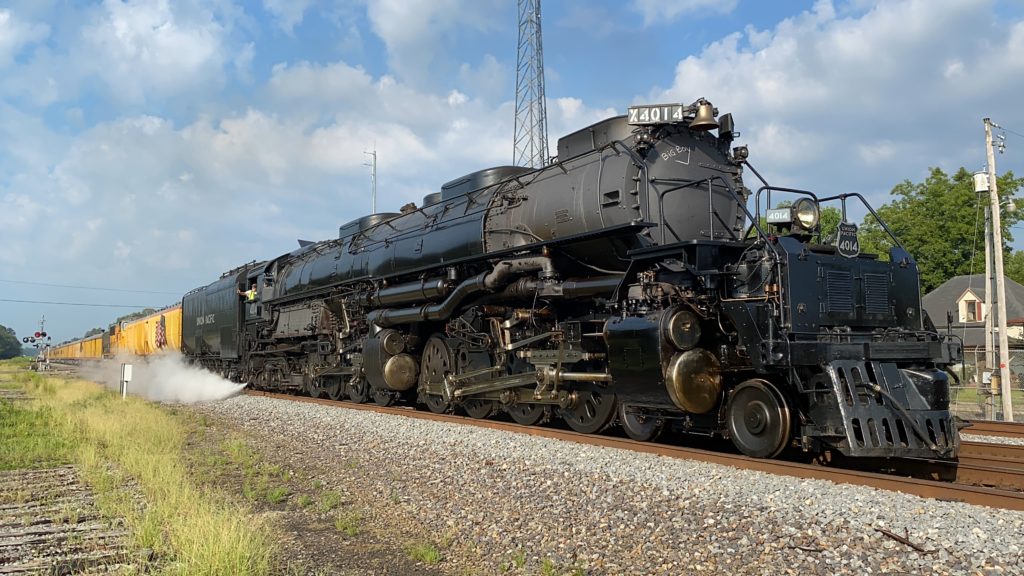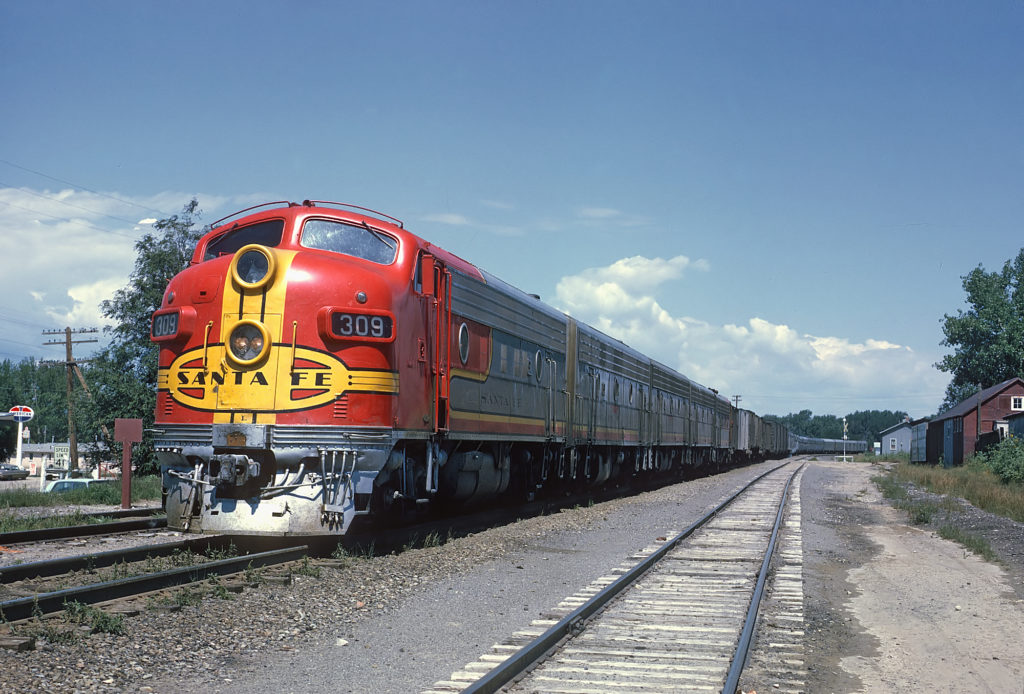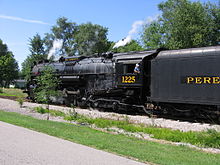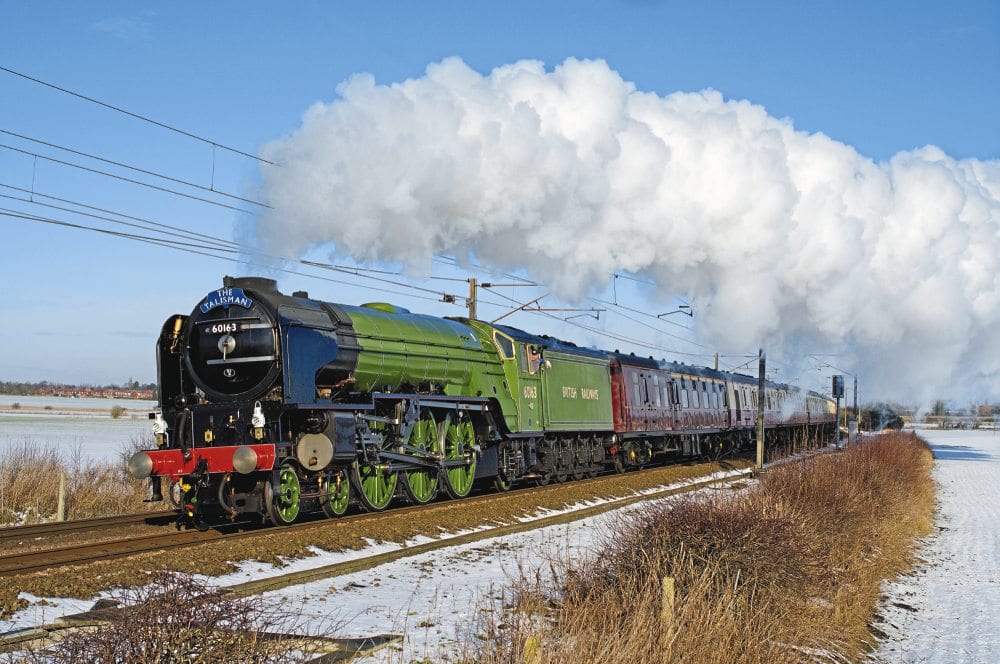
Tornado is a train that was built entirely in 2008 and has been in several movies such as “Paddington 2” “and “T” p GeGear’sR’ce to the north’.’ The train is also known for reaching 100mph, making it the 1st locomotive to achieve this since the 1960s. Tornado was named by HRH The Prince of Wales and The Duchess of Cornwall at York station on 19 February 2009. The locomotive was named in honor of the crews who flew RAF Tornado fast jets during the first Gulf War in 1990/91 when the project to build the new Peppercorn class A1 steam locomotive was launched. While undertaking test runs to raise its permitted maximum speed, No. 60163 Tornado reached 100mph, a preservation era record, during trials conducted on the East Coast Main Line (ECML) between Doncaster and Newcastle. Tornado is currently limited to 75mph, but it has always been the intention to run the locomotive at speeds up to 90mph to better fit in with other trains on the busy UK rail network.

Flying Scotsman was built in Doncaster, the first locomotive of the newly formed London and North Eastern Railway (LNER). It left the works on 24 February 1923 with number 1472. It was designed by Sir Nigel Gresley as part of the A1 class—the most powerful locomotives used by the LNER at that time. In 1934, Scotsman was clocked at 100mphon, a remarkable test run—officially the first locomotive in the UK to reach that speed. During its Australian tour in 1989, it traveled for 442 miles without stopping – a new non-stop record for a steam engine. After its restoration in 2016, it became a record-breaker again as the oldest mainline working locomotive on BrBritain’sracks.
The Class A4 is a class of streamlined 4-6-2 steam locomotives designed by Nigel Gresley for the London and North Eastern Railway in 1935. Their streamlined design gave them the high-speed capability and instantly recognizable, and one of the class, 4468 Mallard, holds the world record as the fastest steam locomotive. Thirty-five of the class were built to haul express passenger trains on the East Coast Main Line route from London Kings Cross via York to Newcastle and later via Newcastle to Edinburgh, Scotland. They remained in service on the East Coast Main Line until the early 1960s, when they were replaced by Deltic diesel locomotives; they proved to be worthy successors to the A4s while most other diesel locomotives failed. Several A4s saw out their remaining days until 1966 in Scotland, particularly on the Aberdeen – Glasgow express trains, for which they were used to improve the timing from 3.5 to 3 hours.
Twenty-five Big Boys were built exclusively for the Union Pacific Railroad, the first of which was delivered in 1941. The locomotives were 132 feet long and weighed 1.2 million pounds. Because of their extraordinary length, the frames of the Big Boys were “hanged,” “r articulated, to allow them to negotiate curves.They had a 4-8-8-4 wheel arrangement, which meant they had four wheels on the leading set of “p” lot” “heels which guided the engine, eight drivers, another set of eight drivers, and four wheels following which supported the rear of the locomotive. The massive engines generally operated between Ogden, Utah, and Cheyenne, Wyo. There are seven Big Boys on public display in various cities around the country. They can be found in St. Louis, Missouri; Dallas, Texas; Omaha, Nebraska; Denver, Colorado; Scranton, Pennsylvania; Green Bay, Wisconsin; and Cheyenne, Wyoming.
The F7 was the Electro-Motive’s four entry in its line of freight service locomotives and proved to be one of the most successful designs of any type ever built. The model debuted directly after the F3 in the late 1940s, and with EMD’s success in the market up to that point, railroads quickly placed orders for the F7. Once again, the newest F model proved efficient, rugged, and easy to maintain. Before production had ended on the F7, nearly 4,000 units were produced, outselling all other manufacturers’ designs combined. The F7 proved so reliable and valuable for many roads that hundreds remained in regular freight service through the 1970s and 1980s. Today, numerous F7’s remain preserved (partially due to being the last model of its kind manufactured on a large scale), and some even continue to haul freight, a true testament to their design. The most famous set (a pair of B units) is the fleet owned by Class I Norfolk Southern used as part of its official business train.

http://www.rail.co.uk/locomotives-and-engines/diesel-engines/british-rail-class-55/
The distinctive growl of Class 55 “Deltic” cannot be mistaken. This locomotive remains a favorite for enthusiasts and crews alike. For many years, Class 55 was the mainstay of the British Rail fleet on the East Coast Mainline, whilst whisking passengers to their destination faster than any locomotive previously. The “Deltic” was introduced during a time when British Rail was looking to standardize their diesel locomotives, of which, many examples have not been successful, as they had various reliability issues, and accrued high maintenance costs due to the non-standard locomotive classes. However, the Deltic locomotives set the stage for high speed running in the future.”
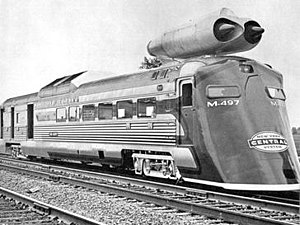
https://en.wikipedia.org/wiki/M-497_Black_Beetle
One of the more exotic experiments to come out during the end of the private passenger train era was New York Central’s experimental M-497 turbojet train, also known by its nickname as the Black Beetle. The unit was designed to bring the public back to the rails and as the title suggests it was powered using jet engines from an aircraft as its main propulsion. To keep costs down the NYC purchased these engines second-hand and used an older Budd Company Rail Diesel Car as the guinea pig. The end result was something that looked as if it came out of a period science-fiction movie. However, the unit actually worked and went on to set the land speed record for a light rail vehicle. While the one unit ultimately built proved successful during a weekend in the 1960s it was never seriously considered for wide-scale production and eventually scrapped during the early 1980s after spending years as a used parts source.
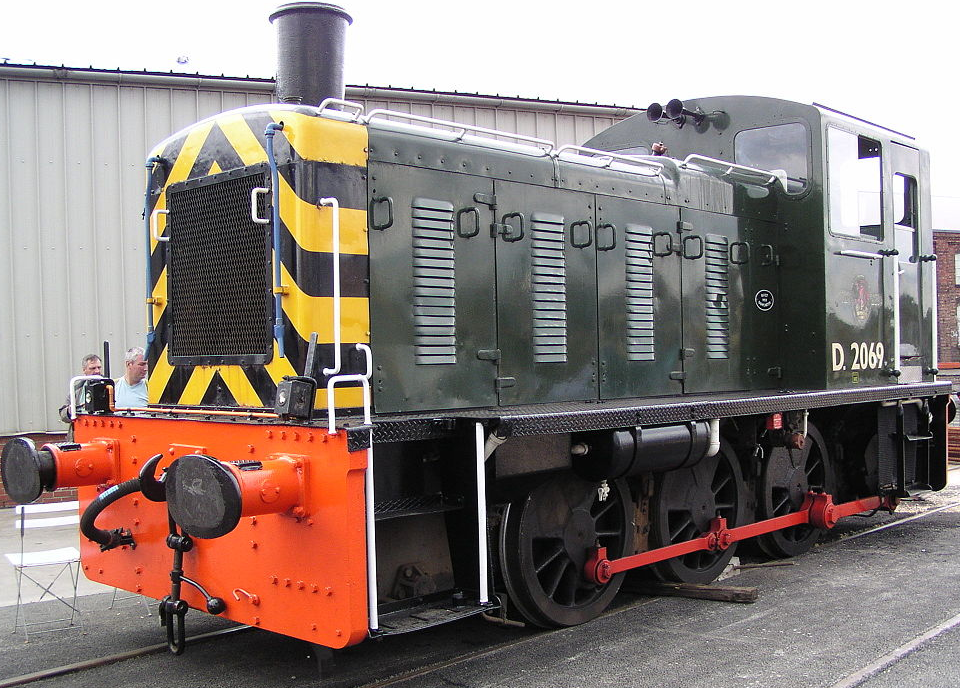
http://www.rail.co.uk/locomotives-and-engines/diesel-engines/british-rail-class-03/
The British Rail Class 03 locomotive was one of the British Rail’s most successful 0-6-0 diesel-mechanical shunters, along with the similar Class 04. The class, numbering 230 examples in total, were built by British Railways’ Swindon and Doncaster works from 1957-1962 and were numbered D2000-D2199 and D2370-D2399 (later 03004 to 03399). D2370 and D2371 were originally numbered 91 and 92 respectively and used as departmental locomotives. The Class 03, like other shunters of this size, was built for light duties where a larger locomotive was not needed, particularly for shunting at locomotive and carriage depots and as station pilots, or where larger or heavier locomotives could not be used. Over time the reduction in the demand for shunting locomotives meant that from 1968 onwards they were progressively withdrawn, many of which were sold to private industry. However, some remained in service much longer, with two examples on the Isle of Wight lasting until 1993.

https://scmaglev.jr-central-global.com/about/design/
The Superconducting Maglev (SCMAGLEV) is the latest advancement in the world of high-speed ground transportation. This revolutionary system is not your typical train. In development since 1962, the SCMAGLEV is a futuristic magnetic levitation system that uses powerful magnetic forces for all aspects of the operation—acceleration, deceleration, guidance, and levitation—resulting in operating speeds of over 300 miles per hour in everyday service, and travel times, unlike anything traditional trains can achieve. The L0 Series is a high-speed maglev train that the Central Japan Railway Company is developing and testing. JR Central plans to use the L0 series on the Chūō Shinkansen railway line between Tokyo and Osaka, which is under construction. The L0 series uses the Japanese-designed SCMaglev system.

The Milwaukee Road’s class ES-2 comprised four electric switcer locomotives. Two were built in 1916 and the final two in 1919. They were of steeple cab design, with a single roof-mounted pantograph to access Milwaukee’s 3,000 V DC overhead line. Originally numbered 10050–10053, they were renumbered E80–E83 in March 1939. The ES-2 was Milwaukee Road’s primary class of dedicated electric switchers. From 1951 to 1974, one ES-2 was the Deer Lodge switcher, while another unit served to switch the yard at Butte. One unit was held in reserve at Deer Lodge to substitute for either of the other two. The E83 became surplus and was scrapped in 1952. The other three continued in service until the end of electric operations on the Milwaukee Road on June 15, 1974. The E82 was also the last Milwaukee electric locomotive to operate on the final day after the Little Joes were stored upon arrival at Deer Lodge. None survived into preservation.
The Intercity Express is a system of high-speed trains predominantly running in Germany. It also serves some destinations in Austria, Denmark (ceased in 2017 but planned to resume in 2022), France, Belgium, Switzerland, and the Netherlands mostly as part of cross-border services. It is the highest service category of rail and the flagship train of the German state railway, Deutsche Bahn. There are currently 259 trainsets in use. ICE trains are the highest category (Class A) trains in the fare system of the Deutsche Bahn. Their fares are not calculated on a fixed per-kilometer table as with other trains, but instead, have fixed prices for station-to-station connections, levied on the grounds that the ICE trains have a higher level of comfort. Traveling at speeds up to 320 km/h (200 mph), they are tailored for business travelers or long-distance commuters and are marketed by Deutsche Bahn as an alternative to flights.
Pere Marquette 1225 is a class “N-1” 2-8-4 “Berkshire” type steam locomotive built in October 1941 for the Pere Marquette Railway (PM) by Lima Locomotive Works (LLW) in Lima, Ohio. No. 1225 is one of two surviving Pere Marquette 2-8-4 locomotives, the other being 1223, which is on display at the Tri-Cities Historical Society near the ex-Grand Trunk Western (GTW) coaling tower in Grand Haven, Michigan. It is perhaps most famous for serving as the basis for the locomotive in the 2004 film, The Polar Express. The Pere Marquette Railway used No. 1225 in regular service from the locomotive’s construction in 1941 until the railroad merged into Chesapeake and Ohio Railway (C&O) in 1947; it remained in use on C&O’s Michigan lines until 1951. Slated for scrapping, 1225 was acquired by Michigan State University in 1957 and placed on static display.


